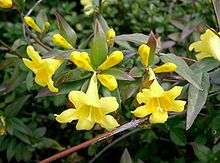Gelsemium
Gelsemium is an Asian and North American genus of flowering plants belonging to family Gelsemiaceae. The genus contains three species of shrubs to straggling or twining climbers. Two species are native to North America, and one to China and Southeast Asia.[2]
| Gelsemium | |
|---|---|
 | |
| Gelsemium sempervirens[1] | |
| Scientific classification | |
| Kingdom: | Plantae |
| Clade: | Tracheophytes |
| Clade: | Angiosperms |
| Clade: | Eudicots |
| Clade: | Asterids |
| Order: | Gentianales |
| Family: | Gelsemiaceae |
| Genus: | Gelsemium Juss. |
| Synonyms[2] | |
| |
Carl Linnaeus first classified G. sempervirens as Bignonia sempervirens in 1753; Antoine Laurent de Jussieu created a new genus for this species in 1789. Gelsemium is a Latinized form of the Italian word for jasmine, gelsomino. G. elegans is also nicknamed "heartbreak grass".[3]
Properties
All three species of this genus are poisonous.
Active components
The active components of gelsemium are the alkaloids, which are present in a concentration of about 0.5%. These consist primarily of gelsemine (a highly toxic compound related to strychnine), with lesser amounts of related compounds (gelsemicine, gelsedine, etc). Other compounds found in the plant include scopoletin (also called gelsemic acid), a small amount of volatile oil, fatty acid and tannins.[4]
Medicinal uses
As late as 1906, a drug called Gelsemium D3, made from the rhizome and rootlets of Gelsemium sempervirens, was used in the treatment of facial and other neuralgias. It also proved valuable in some cases of malarial fever, and was occasionally used as a cardiac depressant and in spasmodic affections, but was inferior for this purpose to other remedies.[7]
Species
| Species | Common names | Areal | Characteristics | Image |
|---|---|---|---|---|
| Gelsemium elegans | heartbreak grass | Native to India, Indonesia, Laos, Malaysia, northern Myanmar, Taiwan, northern Thailand, Vietnam, and the Chinese provinces of Fujian, Guangdong, Guangxi, Guizhou, Hainan, Hunan, Jiangxi, Yunnan, and Zhejiang | Twining climber, found in scrubby forests and thickets from 200–2000 meters elevation | |
| Gelsemium rankinii | Rankin's jessamine, swamp jessamine, Rankin's trumpetflower | Native to southeastern United States | .jpg) | |
| Gelsemium sempervirens | yellow jessamine, Carolina jessamine, evening trumpetflower | Native to southeastern and south-central United States from Virginia to Texas and south through Mexico to Central America | It is commonly grown as a garden flower worldwide |  |
Alleged poisoning victims
- On 23 December 2011, Long Liyuan, a Chinese billionaire, died after eating cat-stew that was allegedly poisoned with Gelsemium elegans.[8][9]
- On 10 November 2012 Alexander Perepilichny died outside his UK home, after warning of Kremlin death threats he received related to the Magnitsky affair. A lawyer for the deceased's life insurance company told a pre-inquest hearing that toxicology reports had identified traces of gelsemium in his body.[10][11] However, this was later denied by an expert at the Royal Botanical Gardens, Kew, and the Police and coroner concluded that he died of natural causes.[12]
Symptoms of poisoning
The poison affects the vision and respiration.[13] Symptoms can appear almost immediately.[14]
Arthur Conan Doyle's experiment
Sir Arthur Conan Doyle, writer of the Sherlock Holmes series, once administered himself a small amount of gelsemium and kept increasing the amount every day until he could no longer stand the ill effects. In a letter written by him to the British Medical Journal on 20 September 1879, he described that he had persistent diarrhoea, severe frontal headache, and great depression, and therefore stopped his self-experimentation at 200 minims.[15][16][17]
References
- 1897 illustration from Franz Eugen Köhler, Köhler's Medizinal-Pflanzen
- Ornduff, R (1970). "The systematics and breeding system of Gelsemium (Loganiceae)". Journal of the Arnold Arboretum. 51 (1): 1–17. doi:10.5962/bhl.part.7036. includes description, drawings, distribution map, etc.
- Lewis, Leo (2012-01-04). "A purrfect murder? Tycoon killed by poisoned cat stew". The Times. Retrieved 2012-01-04.
...the fatal dose of Gelsemium elegans, a highly poisonous plant known as 'heartbreak grass'
- Drugs, Gelsemium
- Wenkert, Ernest (1962). "Gelsedine1". The Journal of Organic Chemistry. 27 (12): 4123–4126. doi:10.1021/jo01059a001.
- Przybylska, M. (1962). "The crystal structure of (−)-N-methyl-gelsemicine hydriodide". Acta Crystallographica. 15 (4): 301–309. doi:10.1107/S0365110X6200078X.
- Gilman, D. C.; Peck, H. T.; Colby, F. M., eds. (1906). . New International Encyclopedia (1st ed.). New York: Dodd, Mead.
- "China tycoon "ate poisoned cat-meat stew"". BBC News.
- "Police: Poisoned cat meat killed China tycoon". Time. 3 January 2012. Archived from the original on 9 February 2012. - using G. elegans
- "Russian whistleblower had traces of rare poison in stomach, plant expert says". London, UK: The Guardian.
- "Alexander Perepilichny: Rare Chinese poison found in stomach of Russian whistleblower". ABC News. 20 May 2015. Retrieved 2 June 2015.
- "[no title cited]". BBC News.
- "Gelsemium". Botanical.com. Retrieved 2 June 2015.
- Devlin, Hannah (18 May 2015). "Gelsemium: the plant that can cause convulsions, paralysis and asphyxia". The Guardian. Retrieved 2 June 2015.
- Doyle, Arthur Conan (1986). Gibson, J.M.; Green, R.L. (eds.). Letters to the Press. University of Iowa Press.
- Doyle, Arthur Conan (20 September 1879). "Arthur Conan Doyle takes it to the limit". British Medical Journal. BMJ Publishing Group Ltd. Retrieved 2 February 2014.
- Doyle, Arthur Conan (20 September 1879). "Letters, Notes, and Answers to Correspondents". British Medical Journal. BMJ Publishing Group Ltd. Retrieved 2 February 2014.